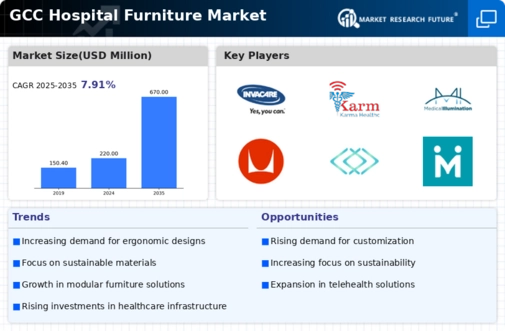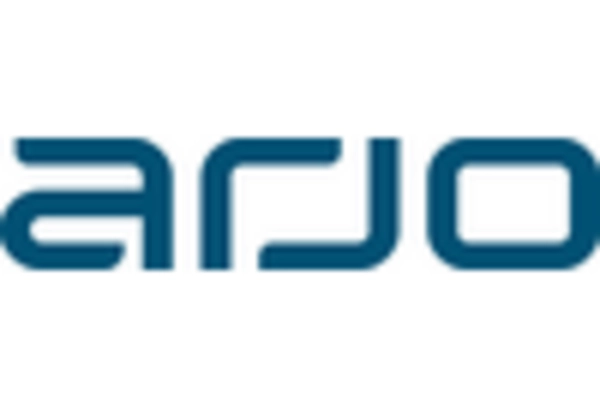Aging Population
The demographic shift towards an aging population in the GCC is significantly influencing the hospital furniture market. As the proportion of elderly individuals increases, there is a corresponding rise in the demand for healthcare services and facilities tailored to their needs. This demographic trend necessitates the provision of specialized hospital furniture designed for comfort and accessibility, such as recliners and height-adjustable beds. By 2030, it is estimated that the elderly population in the GCC will account for over 15% of the total population, thereby creating a substantial market for hospital furniture. This growing segment is likely to drive innovation and customization in furniture design, ensuring that healthcare environments are conducive to the needs of older patients.
Rising Healthcare Expenditure
The hospital furniture market is experiencing growth due to the increasing healthcare expenditure in the GCC region. Governments and private entities are investing heavily in healthcare infrastructure, which includes the procurement of advanced hospital furniture. For instance, healthcare spending in the GCC is projected to reach $104 billion by 2025, indicating a robust demand for quality hospital furniture. This surge in investment is likely to enhance the overall patient experience and operational efficiency within healthcare facilities. As hospitals expand and modernize, the need for specialized furniture, such as adjustable beds and modular furniture systems, becomes more pronounced. Consequently, this driver is pivotal in shaping the hospital furniture market, as it aligns with the broader goals of improving healthcare delivery and patient outcomes.
Increased Focus on Infection Control
The heightened awareness of infection control measures is a critical driver for the hospital furniture market. In the GCC, healthcare facilities are prioritizing the use of materials and designs that facilitate easy cleaning and minimize the risk of infection transmission. This trend is leading to a preference for hospital furniture made from antimicrobial materials and those that can withstand rigorous cleaning protocols. As a result, manufacturers are innovating to produce furniture that meets these stringent requirements. The hospital furniture market is expected to see a shift towards products that not only enhance patient comfort but also adhere to infection control standards, thereby influencing purchasing trends and market growth.
Government Initiatives and Regulations
Government initiatives and regulations play a significant role in shaping the hospital furniture market. In the GCC, various governments are implementing policies aimed at enhancing healthcare infrastructure, which includes the procurement of hospital furniture. These initiatives often come with funding and support for healthcare facilities to upgrade their equipment and furnishings. For example, the introduction of standards and guidelines for hospital furniture design and safety is likely to influence market dynamics. As compliance with these regulations becomes essential, manufacturers are compelled to innovate and adapt their products accordingly. This driver is crucial for ensuring that the hospital furniture market aligns with national healthcare objectives and quality standards.
Technological Advancements in Healthcare
Technological advancements are reshaping the hospital furniture market, as innovations in materials and design enhance functionality and patient care. The integration of smart technologies into hospital furniture, such as beds equipped with monitoring systems and adjustable features, is becoming increasingly prevalent. This trend is driven by the need for improved patient outcomes and operational efficiency within healthcare settings. The hospital furniture market is projected to grow at a CAGR of 6.5% from 2025 to 2030, largely due to these technological advancements. As hospitals seek to adopt cutting-edge solutions, the demand for furniture that supports these technologies is likely to rise, thereby influencing purchasing decisions and market dynamics.

















Leave a Comment